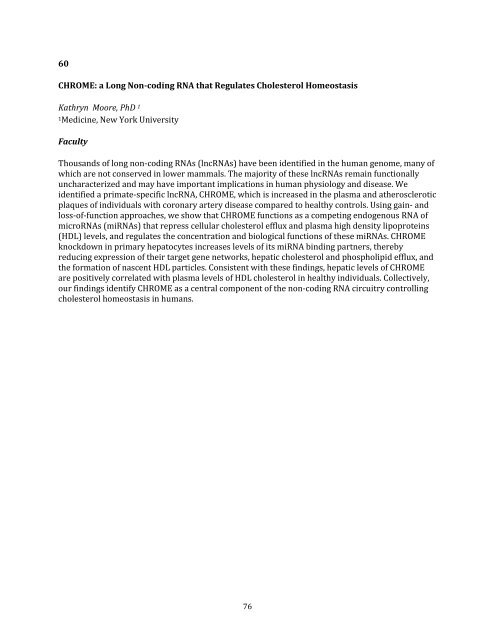2017 Cardiovascular Research Day Abstract Book
Create successful ePaper yourself
Turn your PDF publications into a flip-book with our unique Google optimized e-Paper software.
60<br />
CHROME: a Long Non-coding RNA that Regulates Cholesterol Homeostasis<br />
Kathryn Moore, PhD 1<br />
1Medicine, New York University<br />
Faculty<br />
Thousands of long non-coding RNAs (lncRNAs) have been identified in the human genome, many of<br />
which are not conserved in lower mammals. The majority of these lncRNAs remain functionally<br />
uncharacterized and may have important implications in human physiology and disease. We<br />
identified a primate-specific lncRNA, CHROME, which is increased in the plasma and atherosclerotic<br />
plaques of individuals with coronary artery disease compared to healthy controls. Using gain- and<br />
loss-of-function approaches, we show that CHROME functions as a competing endogenous RNA of<br />
microRNAs (miRNAs) that repress cellular cholesterol efflux and plasma high density lipoproteins<br />
(HDL) levels, and regulates the concentration and biological functions of these miRNAs. CHROME<br />
knockdown in primary hepatocytes increases levels of its miRNA binding partners, thereby<br />
reducing expression of their target gene networks, hepatic cholesterol and phospholipid efflux, and<br />
the formation of nascent HDL particles. Consistent with these findings, hepatic levels of CHROME<br />
are positively correlated with plasma levels of HDL cholesterol in healthy individuals. Collectively,<br />
our findings identify CHROME as a central component of the non-coding RNA circuitry controlling<br />
cholesterol homeostasis in humans.<br />
76


